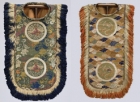Japanese Gallery (Honkan) Room 9
January 13, 2010 (Wed) - March 7, 2010 (Sun)
Bugaku is a performing art combining music and dance. It entered Japan from continental Asia, primarily China and Korea, at the end of the 8th century. From the Nara to the Heian periods, bugaku evolved into a distinctly Japanese art form which came to be employed ceremonially at the imperial court as well as at temples and shrines. This tradition continued throughout the middle ages and early modern times, mainly through annual festivals and celebrations held by the nobility or by temples and shrines.
As the imperial court placed supreme importance upon the observance of courtly custom and social formalities, traditional styles have been colorfully preserved in bugaku costumes.
To-gaku
:
Of Chinese origin, this type of bugaku is also known as bugaku "of the left," and is performed in red costumes.
Komagaku
:
Also known as bugaku "of the right," this style is of Korean origin and is characterized by blue costumes.
Styles of bugaku dance can additionally be categorized as follows.
Hira-mai
:
Performed by several dancers using gentle movements and wearing standard bugaku costumes.
Bu-no-mai
:
A heroic dance, performed by dancers with swords or spears wearing costumes with exotic foreign designs.
Hashiri-mai
:
An energetic dance making use of masks and uchikake-style costumes.
This exhibition focuses on masks and costumes from "Nasori" and "Ryo-o," two hashiri-mai style bugaku works which are considered sister pieces. Displayed together with instruments used in court music, these costumes provide a glimpse into the elegant colors and designs nurtured by court culture.

